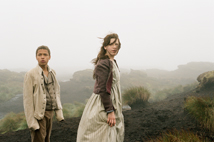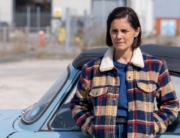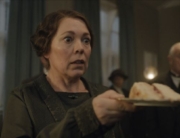
Solomon Glave and Shannon Beer as the young Heathcliff and Cathy (Oscilloscope Laboratories)
Of the various film adaptations of Emily Brontë’s brooding, multigenerational 1847 novel Wuthering Heights, British director Andrea Arnold triumphs where others have either given short shrift or speedily barreled through. She devotes more than half of her film to the story’s chronological beginning: the developing, and symbiotic, bond between the preadolescent Cathy and her adopted brother, Heathcliff, a homeless boy her father has brought from Liverpool to the family’s isolated farm on the Yorkshire moor. Hence, Cathy and Heathcliff’s mercurial behavior, both as kids and later as adults, in this update becomes logical. Arnold takes the epic love story and brings it crushingly back down to earth.
Many of the previous adaptations zero in on the triangle between the grown-up Heathcliff, Cathy, and her husband, Edgar, or on Heathcliff’s revenge, which gave off a high-voltage charge in the recent Masterpiece Classics version, with a virile and strapping Tom Hardy as Heathcliff. Almost all versions downplay the novel’s Gothic elements; where is Cathy’s ghost? In Arnold’s, the younger duo, newcomers Shannon Beer and especially Solomon Glave, are terrific. And in the casting of Glave, who is black, and Beer, who is white, Arnold heightens the contrast between the boy and his adopted family, namely the open hostility between him and his jealous brother Hindley (Lee Shaw). The specificity of Heathcliff’s ethnicity and his sense of feeling like an alien enhance this update. (In the novel, most assume he’s a Gypsy.) Though this retread’s set in the novel’s original 18th century setting, the neatly shaven-headed Hindley looks like a modern day football hooligan.
Arnold also leaves in the film what many directors would overlook: the moment when Heathcliff falls in love. Here, Heathcliff flees from a church service bewildered after being pushed and shoved into becoming baptized. Who wouldn’t be? He hasn’t yet fully learned English, and what denominaton, by the way, completely dunks a head into a pale of water, the movieland Church of the Dour? Cathy also bolts out of the congregation in solidarity with her brother, and she and Heathcliff receive a beating from their father when they get home. As Cathy cries in her bed, Heathcliff, lying on the floor just feet away from her, realizes there’s nothing she wouldn’t do for him. The beatific close-up of Heathcliff rationalizes all the extreme and feral behavior that follows years later, no matter how off-putting it is to witness.
For the most part, the script reveres the fundamentals of the first half of Brönte’s novel. Even so, Arnold knocks the work off its high-culture pedestal back into the mud. Cathy’s family farmhouse, Wuthering Heights, is no longer an elegant estate from movies past. It languishes in genteel poverty—you get a strong whiff of what life would have been like there: chamber pots are emptied and animals are slaughtered—yes, on screen. However, none of the other versions have captured the misty hardscrabble landscape and its variable weather in a way that has been integral to the shaping of the characters and the story, until now. The hand-held camera revels in nature, with extreme close-ups of the soil, leaves, cobwebs, or Cathy’s tangle of russet hair, making the film more tactile than a 3-D movie, but often at the expense of its momentum. The rapid onslaught of jump cuts to a decomposing carcass, a rotting half-eaten apple, or Catherine wallowing in the mud become wearisome.
In the last 45 minutes, the film jumps into the future with Heathcliff returning to the moors as a man of some wealth and Cathy having married the moneyed and priggish Edgar. The couple is then played by adult actors James Howson and Kaya Scodelario. Thus, the film is back to square one, having to rebuild the connection between these two and the audience. But it doesn’t happen. Heathcliff and Catherine are literally transformed characters, and as the story picks up pace, bringing the macabre out of Brontë, it leaves the audience behind. Arnold takes no half-measures in her rendering of Heathcliff’s brutality, and the violence onscreen is more unsettling than just reading it. And this time around, Cathy and Heathcliff consummate their relationship. Well, in a way; you won’t confuse Arnold’s film with the others. Unfortunately, the continuous cuts to scenes that have occurred only minutes earlier of the younger Heathcliff and Catherine accidentally point out that their older counterparts lack the spontaneity, or that fire in the belly, of their younger selves.






Leave A Comment